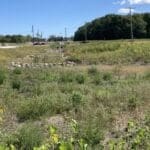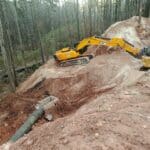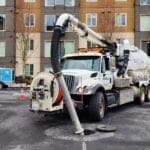City of Dayton
In compliance with the issuance of the NPDES permit, the City of Dayton began implementation of a system-wide SWMP in 1997. The SWMP provides comprehensive planning procedures, which involve intergovernmental coordination, to reduce the discharge of pollutants to the maximum extent practicable. Using best management practices (BMPs), defined as: “Schedules of activities, prohibitions of practices, maintenance procedures, control techniques, system design and engineering methods,” where appropriate, prevent and reduce the pollution of waters of the State. BMPs also include treatment requirements, operating procedures, and practices to control facility site runoff, spillage or leaks, sludge or waste disposal, or drainage from raw material storage.
The City of Dayton has implemented the SWMP to manage the quality of urban storm water discharged to waters of the state through the Municipal Separate Storm Sewer System (MS4). The City of Dayton encompasses 56.4 square miles. The City owns and operates the MS4 which has almost 600 miles of storm sewers, 21,000 catch basins, 15,000 manholes, 15 storm pumping stations, and over 500 storm water outfalls.
Best Management Practices, when used singularly or in combination prevent or reduce the release of pollutants and other adverse impacts to surface waters. The objective of BMPs is to control the quality and/or quantity of stormwater in order to reduce the adverse impact of storm water on Dayton’s local receiving waters:
|
TABLE #1: DAYTON’S RECEIVING WATERS
|
- Great Miami River and unnamed tributaries
|
|
- Mad River and unnamed tributaries
|
- Tributary to Little Beavercreek
|
- Stillwater River and unnamed tributaries
|
- Tributary to Opossum Creek
|
- Wolf Creek and unnamed tributaries
|
|
Dayton’s SWMP includes BMPs which have been developed and implemented by various departments and divisions throughout the City organization. Storm Water Management is a coordinated effort by a diverse group of professionals. The SWMP is managed by the Department of Water, Division of Environmental Management (DEM). To optimize implementation of BMPs to meet the SWMP goals, responsibilities are delegated to the department with direct control.
As a requirement of the City’s NPDES permit, Dayton enacted a stormwater ordinance in 1997 and has since amended the chapter to include the stormwater utility fee. This established fee, the Municipal Stormwater Fund, shall be used solely for the construction, operation and maintenance, and pollution prevention and elimination activities of the municipal separate storm sewer system. All owners of real property in Dayton must pay this fee based on the amount of impervious area on their property. The ordinance also requires the owner of private drainage facilities from a building or an inlet structure to the MS4 to be responsible for all maintenance associated with such facilities. Failure to maintain private stormwater controls and facilities can result in a notice of violation and large fines.
DAYTON, OHIO MUNICIPAL CODE
CHAPTER 54. – STORMWATER MANAGEMENT
Sec. 54.01. · General.
(A) Purpose. This chapter is adopted to protect public surface and groundwaters from degradation by accelerated soil erosion and other pollutants; and to maintain compliance with the City of Dayton National Pollutant Discharge Elimination System (NPDES) Permit No. 1 PI00003*CD. Protection from such degradation shall promote and maintain the health, safety, and general well-being of all inhabitants of the city and surrounding region.
Sec. 54.02. ·Powers of the director.
The Director shall administer, implement, and enforce the provisions of §54.01 through 54.10. Any powers granted or duties imposed upon the Director may be delegated in writing to persons or entities acting in the beneficial interest of or in the employ of the city. The Director shall have power to make rules for the management and protection of the MS4 and to prevent the pollution thereof; to make rules consonant with §54.01 to 54.10; to classify storm sewer services; to establish, adjust, and regulate the rates charged for different classes of storm sewer services; to enforce the provisions of §54.01 through 54.10 and to exercise all incidental powers necessary to carry out the purposes of Chapter 54.
(Ord. 30811-08, § 1, 11-26-08)
Sec. 54.03. – Stormwater utility.
For the protection of the public health, safety, welfare, and convenience of the city and its inhabitants a stormwater utility is hereby established to manage, maintain, operate, repair, construct, reconstruct, and enlarge the city’s Municipal Separate Storm Sewer System. The stormwater utility is administered by the Director.
(Ord. 30811-08, § 1, 11-26-08)
Sec. 54.04. – Stormwater charges.
- There is hereby charged and imposed upon all real property having an impervious surface area located within the city, whether publicly or privately owned, a fee for benefits occurring from the stormwater utility. All owners of such real property are responsible for payment of fees charged their properties. A Municipal Stormwater Fund is established to receive all fees collected pursuant to this chapter.
- All fees collected for stormwater service shall be placed in the Municipal Stormwater Fund and shall be used solely for the construction, operation and maintenance, and pollution prevention and elimination activities of the municipal separate storm sewer system. Funds shall not be used for private purposes or to extend storm sewer services to unsewered areas. The first priority for the expenditure of this fund shall be to address the specific requirements of the city’s stormwater discharge permit for the Municipal Separate Storm Sewer System.
- Public streets and airports owned and operated by the city are not subject to the stormwater fees.
- Unpaid stormwater service fees shall constitute a lien against the property. Unpaid stormwater service fees may be certified to the County Auditor for collection with the property owner’s real property tax payment.
- Stormwater fees may be appealed to the Director. Decisions of the Director may be appealed to the Board of Water and Sewer Charge Appeals in accordance with the procedures set forth in R.C.G.O. §§ 50.20 through 50.28. The respective boards shall have such powers with respect to stormwater fees as they have with respect to water and sanitary sewer service charges.
(Ord. 30811-08, § 1, 11-26-08;Am. Ord. 31027-10, § 1, 10-6-10)
Sec. 54.05. – Earth-disturbing activity.
- No person may engage in earth-disturbing activity without complying with the provisions of this chapter, the “City of Dayton, Ohio, Construction and Materials Specifications,” the rules and standards published by the Director, and the Ohio EPA’s NPDES Construction Activity General Permit.
No person may engage in earth-disturbing activity of one acre or more without a SWP3 approved by the Director or the Ohio Environmental Protection Agency.
- No person required to have an approved SWP3 shall conduct earth-disturbing activity in a manner inconsistent with the approved plan. No person shall conduct earth-disturbing activity on any portion of a property required to have an approved SWP3 in a manner inconsistent with the approved plan.
(Ord. 30811-08, § 1, 11-26-08)
Sec. 54.06. · Subdivision planning and individual site development.
- An applicant for subdivision plan approval or any individual site development for any site of one acre or more, pursuant to R.C. Chapter 151, shall submit a stormwater management program to the Director, developed in accordance with the “City of Dayton, Ohio, Construction and Material Specifications” and standards published by the Director.
- No subdivision plan shall be approved by the City of Dayton Plan Board until the Director has approved those provisions of the plan addressing stormwater drainage.
- In determining whether to approve a SWMP the Director shall consider the following principles:
- The feasibility of the following stormwater management practices:
- Stormwater retention structures;
- Stormwater detention structures; or
- Post-construction stormwater management.
- Where appropriate and consistent with subdivision ordinances, reducing the need for stormwater management facilities by incorporating the use of natural topography.
- Designs that minimize the need for maintenance, provide access for maintenance purposes, and are structurally sound.
- Designs that minimize the likelihood of stormwater pollution by materials and activities at the subdivision.
- No person required to have an approved SWMP may proceed to develop a subdivision without an approved SWMP or conduct subdivision development activity in a manner inconsistent with the approved plan.
- No bond, financial assurance, or part of any bond or financial assurance given pursuant to§ 151.80 shall be released by the City Engineer without the Director’s approval.
(Ord. 30811-08, § 1, 11-26-08)
Sec. 54.07. – Private drainage facilities.
The owner of private drainage facilities from a building or an inlet structure to the MS4 is responsible for all maintenance associated with such facilities.
The owner shall maintain the following:
- Dry wells. Any existing dry wells are required to have a routine maintenance plan to prevent overflow and cause an illicit discharge to the MS4.
- Private Drainage Facilities. The owner shall maintain the private drainage facilities and post-construction controls, on their property in a condition to not cause flooding of stormwater to the city MS4, and to keep the flow free from litter and debris, other waste, and other pollutants.
- Floor Drains. All floor drains within a commercial or industrial facility that connect to the MS4 are considered a point source and shall be covered by an National Pollutant Discharge Elimination System permit or shall be reconnected to the sanitary sewer system or plugged at the owner’s expense.
- Storm Sewer Systems including Laterals. All existing or new storm sewer laterals that require a National Pollutant Discharge Elimination System permit may also require a stormwater pollution prevention plan to prevent illicit discharges to the MS4.
- Storm Ditches and Swales. The owner shall maintain the storm ditches and swales on their property in a condition to not cause flooding of stormwater to the MS4, and to keep the flow free from litter and debris, other waste, and other pollutants.
The owner must retain the services of a licensed plumber and obtain a city permit to perform any repairs to private laterals beyond the owner’s property line in the right-of-way or easement. The owner or designated representative (such as the plumbing contractor) must contact the City of Dayton, Department of Water prior to cutting into in a dedicated street or alley for the purpose repairs to private laterals. Unless otherwise authorized by the city, all excavations, repairs, and restoration in a dedicated street or alley will be performed by the city in cooperation with the contractor being billed for such work. The owner must obtain the requisite city permits for any work on a private lateral; and inspections will be performed on all such work.
(Ord. 30811-08, § 1, 11-26-08)
Sec. 54.08. – Inspections.
- Authorized representatives of the Director may enter at reasonable times upon any property to conduct on-site inspections or investigations, obtain samples, and examine records to determine compliance with this chapter, approved construction plans, or an approved SWP3. Upon refusal the Director or authorized representative may apply for a search warrant to enter upon the property.
- No person shall obstruct or interfere with inspection of any premises or the sampling of any discharge by the Director.
- The Director may collect and analyze samples of discharges to the MS4, install and require the installation of stormwater sampling and measurement devices, and examine records concerning discharges to the MS4. Where adequate facilities do not exist for the installation of stormwater sampling and measurement devices, the Director may order the owner of the property to install such facilities.
(Ord. 30811-08, § 1, 11-26-08)
Sec. 54.10. – Enforcement.
- [Notice of Violation:] Whenever the Director finds a violation of a provision or failure to meet a requirement of § 54.01 through 54.09, and prior to taking any action under paragraphs (B), (C), or (F) of this section, the Director shall order compliance by written notice of violation to the person responsible for the violation.
- Cost of abatement of the violation: Any person who violates any provision of this chapter, or regulation, permit, license, or other directive pursuant to § 54.01 through 54.09 shall be responsible for all costs incurred by the city to abate the violation, including investigation and administrative costs.
- Administrative fines: Upon failure to comply with a notice of violation, the Director may charge administrative fines not to exceed $1,000.00 per violation against any person who violates any provision of this chapter or any regulation, permit, license, or other directive pursuant to § 54.01 through 54.09. Each day a violation occurs shall be considered a separate violation. This fine may be charged separate from the abatement costs. Unpaid administrative fines may be certified to the County Auditor for collection with the responsible party’s real property tax payment.
Sec. 54.11. -Assessment rates and user charge system.
-
Effective January 1, 2020, the annual fee for one-family, two-family, and three-family residential properties having impervious surface area and from which stormwater does not flow directly to the municipal separate storm sewer system is $32.21.
-
Effective January 1, 2020, the annual fee for one-family, two-family, and three-family residential properties having impervious surface area and from which stormwater flows directly to the municipal separate storm sewer system is $69.30.
-
Effective January 1, 2020, the annual rate for all properties other than one-family, two-family, and three-family residential properties having impervious surface area and from which stormwater does not flow directly to the municipal separate storm sewer system is $.0165 per square foot of impervious surface area.
-
Effective January 1, 2020, the annual rate for all properties other than one-family, two-family, and three-family residential properties, having impervious surface area and from which stormwater flows directly to the municipal separate storm sewer system is $.0355 per square foot of impervious surface area.
-
Effective January 1, 2021, the annual fee for one-family, two-family, and three-family residential properties having impervious surface area and from which stormwater does not flow directly to the municipal separate storm sewer system is $32.99.
-
Effective January 1, 2021, the annual fee for one-family, two-family, and three-family residential properties having impervious surface area and from which stormwater flows directly to the municipal separate storm sewer system is $70.86.
-
Effective January 1, 2021, the annual rate for all properties other than one-family, two-family, and three-family residential properties having impervious surface area and from which stormwater does not flow directly to the municipal separate storm sewer system is $.0169 per square foot of impervious surface area.
-
Effective January 1, 2021, the annual rate for all properties other than one-family, two-family, and three-family residential properties, having impervious surface area and from which stormwater flows directly to the municipal separate storm sewer system is $.0363 per square foot of impervious surface area.
-
Effective January 1, 2022, the annual fee for one-family, two-family, and three-family residential properties having impervious surface area and from which stormwater does not flow directly to the municipal separate storm sewer system is $33.77.
-
Effective January 1, 2022, the annual fee for one-family, two-family, and three-family residential properties having impervious surface area and from which stormwater flows directly to the municipal separate storm sewer system is $72.42.
-
Effective January 1, 2022, the annual rate for all properties other than one-family, two-family, and three-family residential properties having impervious surface area and from which stormwater does not flow directly to the municipal separate storm sewer system is $.0173 per square foot of impervious surface area.
-
Effective January 1, 2022, the annual rate for all properties other than one-family, two-family, and three-family residential properties, having impervious surface area and from which stormwater flows directly to the municipal separate storm sewer system is $.0371 per square foot of impervious surface area.
-
For year 2023 and thereafter, unless by amendment, the charges established by this section shall be adjusted annually by the Director beginning January 1 in any given year. In determining the annual adjustment, the Director may utilize the Consumer Price Index (United States Department of Labor Statistics, Consumer Price Index, All Urban Consumers, U.S. City Average, Water and Sewer Maintenance or comparable index if the same is no longer published) as measured by the percent change in the average price index from the third quarter (July-September, hereinafter referred to as the base quarter) of the previous year to the base quarter one year prior; whichever percentage is greater. Prior to any rate adjustment taking effect in accordance with this section, the Director shall cause the new rates to be published electronically and put on file with the Clerk of the City Commission.
-
The city may also develop and assess a system of charges or riders designed to recover from all users, their share of the cost of financing capital improvements or other expenditures to the stormwater system, including, but not limited to, capital costs associated with the financing of notes and bonds to improve and/or expand the stormwater system of the city and/or capital costs associated with compliance with federal, state, or local environmental regulations. The Water Director shall present the necessity and support for charges or riders in public hearing to the City Commission and Commission approval is required prior to assessing such charges or riders.
(Ord. 31027-10, § 2, 10-6-10; Ord. 31785-19, passed 1-8-20)
THE CITY OF DAYTON- ENGINEERING DESIGN STANDARDS
These design standards, in conformance with established practice by the City of Dayton, apply to all commercial, residential, multi-family developments, and capital improvements involving the construction, modification, addition, or removal of public infrastructure including, but not limited to the water distribution system, sanitary collection system, storm water collection system, storm water management and erosion control (both temporary and permanent).
APPENDIX B: POST CONSTRUCTION STORM WATER REQUIREMENT DESIGN GUIDANCE
Appendix B functions as a tool to help developers and designers implement the City of Dayton’s post-construction storm water management program. This section includes 1) guidance on how to select nonstructural post construction storm water best management practices (BMPs) and 2) guidance on how to select, design, and maintain structural post construction storm water BMPs. Temporary soil erosion and sedimentation control BMPs are also discussed in this section.
To incorporate storm water management effectively into a site design, it is essential to consider storm water during the early planning stages and during design to successfully implement storm water BMPs during construction and after construction.
Links
Dayton Water One Source Website
Dayton Stormwater Management Ordinance
 Kenosha, Wis. Highway KR Regenerative Stormwater ConveyanceThe Root-Pike Watershed Initiative Network Kenosha County, and others worked with AQUALIS to design and implement an innovative solution for stormwater control along Highway KR.
Kenosha, Wis. Highway KR Regenerative Stormwater ConveyanceThe Root-Pike Watershed Initiative Network Kenosha County, and others worked with AQUALIS to design and implement an innovative solution for stormwater control along Highway KR. Durham, N.C. Sinkhole Leads to Stormwater System RehabilitationThe tenant on this property noticed a depression that opened to the ground below and notified the property owners.
Durham, N.C. Sinkhole Leads to Stormwater System RehabilitationThe tenant on this property noticed a depression that opened to the ground below and notified the property owners.
